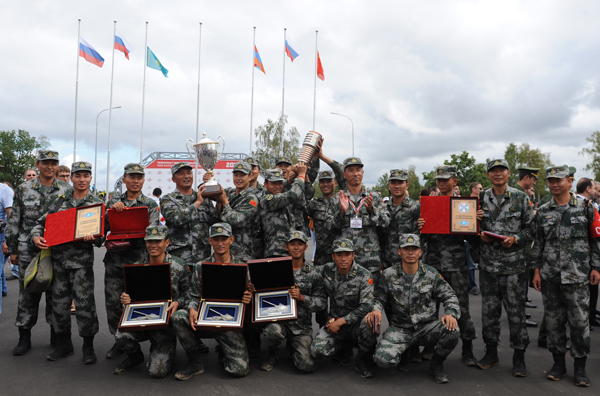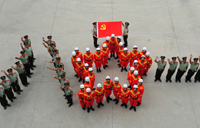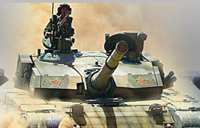Tanks need more power, experts say
By Zhao Lei (China Daily) Updated: 2014-08-18 08:00
 |
|
A Chinese team celebrates after winning third place in a newly created sport-military crossover competition in the Alabino firing range of the Moscow region on Saturday. Jia Yuchen / Xinhua |
China's tanks have advanced weapons, armor and automation systems, but their engines need to be improved, according to military officers and experts.
"The Type-96A main battle tank is the backbone of the armored units in the People's Liberation Army's ground force," said Senior Colonel Li Shengli, head of the training department at the PLA Academy of Armored Forces Engineering.
 |
| Chinese military becoming more transparent? |
 |
| China military watch |
Colonel Yu Kuilong, a researcher at the academy who specializes in vehicle engineering, said the PLA ground force has continually upgraded its armaments over recent years and its tanks are much better than before.
"Now our tanks have supreme performance in terms of maneuverability, firepower and control," he said.
The adoption of cutting-edge ergonomic technologies has substantially reduced the number of complaints about discomfort from soldiers.
"Though the engines of our tanks still need to be improved, their real combat capability must be tested by actual operations rather than a single competition," added Yu, referring to the second Tank Biathlon world championships in Alabino, Russia, that ended on Saturday.
The Chinese team won the bronze medal in the team event, behind first-place Russia and runner-up Armenia. Twelve nations took part in the competition, including Belarus, Venezuela and India.
The PLA sent four Type-96As, while other contestants used the Russian-made T-72 series tank.
The Type-96A is a third-generation main battle tank developed by China North Industries Group Corp based on its Type 88C design. It entered service in 1997, and more than 2,500 are estimated to be in service with the PLA.
Unlike predecessors such as the Type-85 and Type-88, the Type-96A features advanced imaging and jamming instruments, a more-powerful engine, improved electronics, add-on armor modules and explosive reactive armor.
Lieutenant Hou Peng, who took part in the biathlon, said the Type-96A performed well in shooting contests, hitting every target.
"However, the tanks used by the Russian team have a 1,130-horsepower engine that is 300 horsepower more powerful than ours, so their tanks run faster," he told China Central Television.
Chinese engineers are well-aware that the engine's relative lack of power poses a severe problem for the PLA's tank regiments, according to Wang Hongguang, former deputy commander of the Nanjing Military Command, who oversaw the development of the Type-96A.
"The power of the Type-96A's engine is constrained by a host of factors such as its materials, structure and several key parts," he told Global Times.
"However, considering the costs of an upgrade and the fact that it is designed to be deployed in China's central and southern regions, its current speed is fast enough."
Qin Zhen, executive editor of Ordnance Knowledge magazine, said, "In a real battle, what truly matters is a tank's protective armor, use of information, survivability and ability to detect enemies and move faster than them."
Wang added, "The public should be confident in China's tanks."
zhaolei@chinadaily.com.cn
- Govt encourages people to work 4.5 days a week
- Action to be taken as HIV cases among students rise
- Debate grows over reproductive rights
- Country's first bishop ordained in 3 years
- China builds Tibetan Buddhism academy in Chengdu
- Authorities require reporting of HIV infections at schools
- Typhoon Soudelor kills 14 in East China
- Police crack down on overseas gambling site
- Debate over death penalty for child traffickers goes on
- Beijing to tighten mail security for war anniversary







